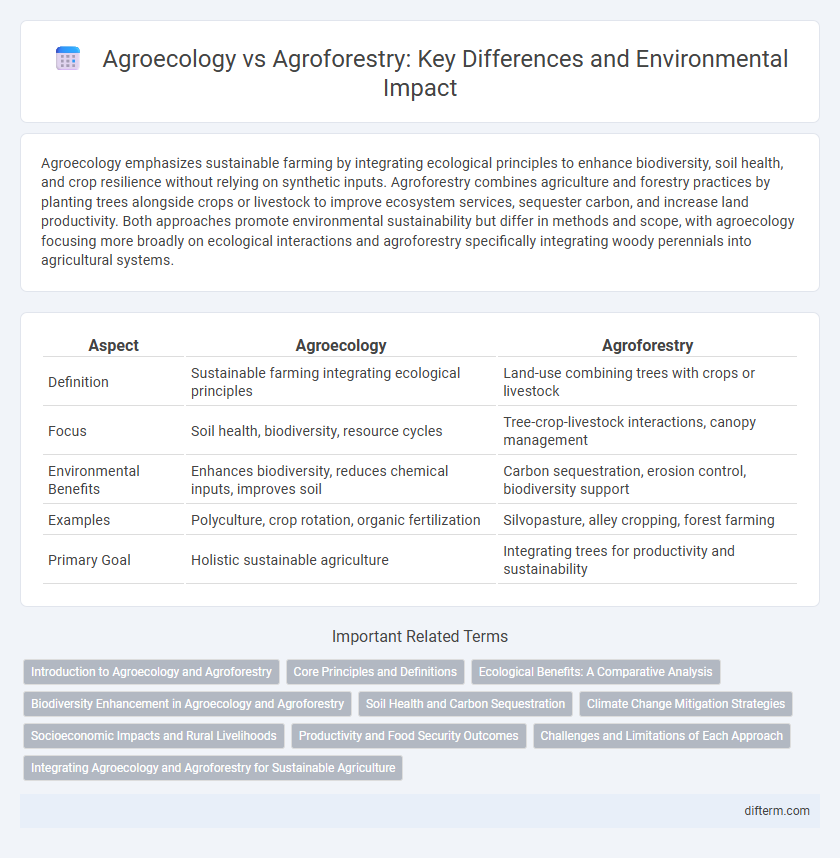Agroecology emphasizes sustainable farming by integrating ecological principles to enhance biodiversity, soil health, and crop resilience without relying on synthetic inputs. Agroforestry combines agriculture and forestry practices by planting trees alongside crops or livestock to improve ecosystem services, sequester carbon, and increase land productivity. Both approaches promote environmental sustainability but differ in methods and scope, with agroecology focusing more broadly on ecological interactions and agroforestry specifically integrating woody perennials into agricultural systems.
Table of Comparison
| Aspect | Agroecology | Agroforestry |
|---|---|---|
| Definition | Sustainable farming integrating ecological principles | Land-use combining trees with crops or livestock |
| Focus | Soil health, biodiversity, resource cycles | Tree-crop-livestock interactions, canopy management |
| Environmental Benefits | Enhances biodiversity, reduces chemical inputs, improves soil | Carbon sequestration, erosion control, biodiversity support |
| Examples | Polyculture, crop rotation, organic fertilization | Silvopasture, alley cropping, forest farming |
| Primary Goal | Holistic sustainable agriculture | Integrating trees for productivity and sustainability |
Introduction to Agroecology and Agroforestry
Agroecology integrates ecological principles into sustainable farming systems by enhancing biodiversity, soil health, and natural resource management to create resilient agricultural landscapes. Agroforestry combines trees and shrubs with crops or livestock, promoting ecosystem services such as carbon sequestration, improved soil fertility, and habitat conservation. Both approaches prioritize environmental sustainability, but agroforestry uniquely emphasizes tree-crop interactions to optimize land use and biodiversity benefits.
Core Principles and Definitions
Agroecology integrates ecological principles into agricultural systems to promote sustainability, biodiversity, and resilience by emphasizing soil health, crop diversity, and natural pest control. Agroforestry combines trees and shrubs with crops or livestock in a symbiotic system to enhance productivity, biodiversity, and ecosystem services like carbon sequestration and water regulation. Core principles of agroecology focus on ecological balance and socio-economic equity, while agroforestry prioritizes the spatial and temporal integration of woody perennials to optimize land use and environmental benefits.
Ecological Benefits: A Comparative Analysis
Agroecology enhances biodiversity by integrating diverse crop species and natural pest control, promoting soil health and reducing chemical inputs. Agroforestry combines trees with crops or livestock, offering superior carbon sequestration, improved microclimates, and habitat connectivity. Both systems contribute to ecosystem resilience but agroforestry provides greater long-term carbon storage and erosion control through tree root structures.
Biodiversity Enhancement in Agroecology and Agroforestry
Agroecology enhances biodiversity by integrating diverse crop species and promoting natural pest control, which improves ecosystem resilience and soil health. Agroforestry boosts biodiversity through the deliberate coexistence of trees and shrubs with crops or livestock, creating habitats that support a wide range of flora and fauna. Both approaches increase ecological complexity and strengthen ecosystem services critical for sustainable agriculture.
Soil Health and Carbon Sequestration
Agroecology promotes soil health by enhancing biodiversity and organic matter through crop rotation and cover cropping, which improves nutrient cycling and microbial activity. Agroforestry integrates trees with crops or livestock, significantly increasing carbon sequestration by storing carbon in woody biomass and soil organic carbon pools. Both practices contribute to sustainable land management but agroforestry offers higher carbon storage potential due to tree biomass accumulation.
Climate Change Mitigation Strategies
Agroecology emphasizes sustainable farming practices that enhance soil health, biodiversity, and carbon sequestration by integrating ecological principles into agricultural systems. Agroforestry incorporates trees and shrubs into crop and livestock systems, which improves carbon storage, reduces greenhouse gas emissions, and increases resilience to climate variability. Both approaches contribute significantly to climate change mitigation by enhancing ecosystem services and promoting carbon sinks in agricultural landscapes.
Socioeconomic Impacts and Rural Livelihoods
Agroecology enhances rural livelihoods by promoting low-input, sustainable farming practices that increase food security and empower smallholder farmers through knowledge sharing and community participation. Agroforestry integrates trees into agricultural landscapes, diversifying income sources with timber, fruits, and non-timber products while improving soil health and resilience to climate change. Both approaches contribute to socioeconomic stability, but agroforestry often provides higher economic returns due to diversified marketable resources.
Productivity and Food Security Outcomes
Agroecology enhances productivity and food security by integrating diverse crop species and sustainable farming practices, which improve soil health and reduce dependency on chemical inputs. Agroforestry combines trees with crops or livestock, boosting productivity through improved microclimates and nutrient cycling, while sequestering carbon and increasing resilience to climate change. Both approaches contribute to food security by promoting ecosystem services, diversifying income sources, and enhancing long-term agricultural sustainability.
Challenges and Limitations of Each Approach
Agroecology faces challenges such as limited scalability and the need for extensive local knowledge to optimize diverse crop interactions, which can hinder widespread adoption. Agroforestry encounters limitations including longer timeframes for tree growth, potential competition between trees and crops for resources, and complexities in managing mixed species systems. Both approaches require robust policy support and farmer training to overcome socioeconomic barriers and achieve sustainable environmental benefits.
Integrating Agroecology and Agroforestry for Sustainable Agriculture
Integrating agroecology and agroforestry enhances sustainable agriculture by combining biodiversity, soil health, and water conservation practices with multi-layered tree-crop interactions that improve microclimates and carbon sequestration. This synergy promotes resilient farming systems that support ecological balance, increase crop yields, and mitigate climate change impacts. Emphasizing native species, organic inputs, and local knowledge further strengthens ecosystem services and farmer livelihoods in diverse agroecosystems.
agroecology vs agroforestry Infographic

 difterm.com
difterm.com